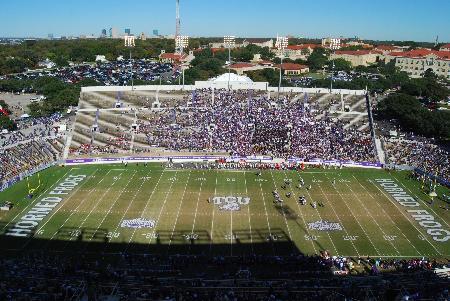The renovation of Amon G. Carter Stadium, scheduled to begin when the football season ends in November, will represent a rare accomplishment in college athletics.
Athletic Director Chris Del Conte said TCU’s stadium would be the first in the country to be renovated or built using money that was raised before the project began.
With the stadium funding already completed, revenue from ticket and suite sales to go straight to the bank. Del Conte said all the added features, such as a club level and luxury suites, were a necessity in building a stadium in this generation.
“When they built stadiums years ago it was just for seating for a spectator,” Del Conte said. “Now they want all the amenities that go along with that and it’s indicative of things that you’re being sold.”
The new version of Amon G. Carter Stadium will have a seating capacity of 40,000, smaller than the 44,008 fans it holds today. The University of North Texas started construction on a new stadium of its own last year because of seating issues at its old one.
UNT’s stadium, Fouts Field, was built in 1951 for a capacity of 20,000 fans. Much of UNT’s drainage system runs under the stadium, and since it was constructed using codes from nearly 60 years ago, it would have been a difficult renovation project.
“There was really no way to bring it into a new age and so we…felt like for us to be committed to Division I football, to be able to recruit for the Division I level, that we needed a place where we could attract the very best student-athletes and create a great place for our fans,” UNT Athletic Director Rick Villarreal said.
The new stadium at UNT, which is being built and will open for the 2011 season, would become a positive thing for not only the university, but for the city of Denton as well, Villarreal said. It will bring more revenue to the city because of the nights people will spend in hotels and the food they will buy at the grocery stores for their tailgate parties.
The stadium’s capacity is expected to be 30,000, about the same as Fouts Field’s current capacity.
“I think for the community it’s a place like we’ve never had,” Villarreal said. “It gives us the ability to bring in concerts and additional high school games to our area.”
Although concerts and other big events have not been mentioned as possibilities for the renovated Amon G. Carter Stadium, the stadium at TCU will have one thing in common with Dallas-Fort Worth’s newest professional stadium: Cowboys Stadium. Both were designed by HKS Sports and Entertainment Group.
The HKS renovation plans call for elevators and escalators, a new seating bowl, a new press box, upgraded restrooms and better concession stands.
“We have an unbelievable product right now at TCU, but our stadium is not indicative of our product,” Del Conte said. “(But) our infrastructure is not enough to
handle the capacity we have.”
By putting $105 million from 34 donors into the renovation project, Del Conte said there is a not only an advantage visually and for the fans, but for the football team as well.
“If you continue to reinvest in your program you make it that much stronger and you have a compounding effect when you can sustain success for a long, long time,” he said. “If you don’t reinvest, you become a one and done.”

